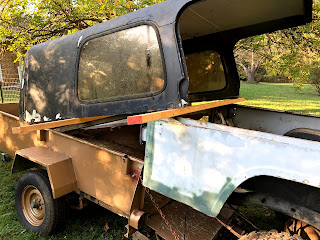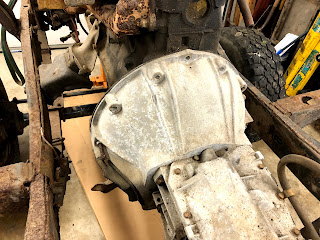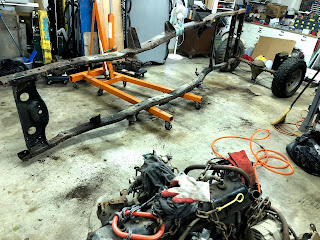I haven't done anything to the Scrambler Project for a couple of weeks.
I did manage to get the bulk of it torn down and separated.
First step, after clearing out all the miscellaneous "stuff" that was inside, was to remove the hardtop.
The hardtop in and of itself needs a lot of love. It was a CJ7 top that someone cut and spliced for the extended length of the Scrambler. It looked like it was pretty decently done, originally. But time and neglect have taken their toll.
When working by oneself, one sometimes has to be creative. I worked the top off in stages.
I first secured 2x4s to keep the sides from flaring out as it was being moved and to give a better bottom surface on which to support the top. Then slid it down ramps onto the utility trailer.
Then it was the same process to get it from the trailer to sitting on blocks.
Then the Jeep was pulled up onto the driveway, turned around and positioned into it's next staging area. That feat took a little bit of time, as there was no steering shaft connecting the steering wheel to the steering box and one of the tires is so dry rotted it doesn't hold air for very long.
It was another week or so before I was able to get anything more done.
Removing the body tub from the frame was the same process.
It didn't take me very long into the teardown to realize that very few, if any of the parts/ components were original to each other. The whole "vehicle" was bolted together with minimal fasteners and many things are missing. Things like the wiring harness, heater box assembly, radiator, etc.
The positive side of that is it didn't take much effort to get everything apart. Replacing the missing items with new, aftermarket parts is most times a good thing. I've run into a few issues on the blue Jeep with using the original 40 year old wiring harness.
Random Maggie pic. She's in her natural habitat. Laying on my pillow...
The body tub is going to need a lot of work. I don't know that much about that type of work, so it's a bit intimidating to me. I'm really on the fence about repairing what I have vs. buying an aftermarket replacement.
There are three options for aftermarket: Fiberglass, steel and Aluminum, each with their own set of pros and cons.
I won't consider fiberglass. Not that I'm intending on selling this, but a fiberglass body is a good way to drive down the value. There can also be fitment issues as components are assembled.
Aluminum is an interesting option. The company that makes them is in Canada. These have good reviews but do not have any holes in them, requiring the end user to cut the holes for things like the steering column, fusebox, brake booster, etc. It is also much lighter than the steel body. Cost is slightly more than steel.
There is one manufacturer of aftermarket steel Jeep tubs. It is a company in the Philippines. From what I have read from numerous sources, these body tubs are very inconsistent, holes are missing or mis-located and some features are typically not there. Some opinions I've read are that for the amount of work involved to make the new tub right, it frequently would be better to have repaired the original.
Replacement panels and structural members for most of it are readily available. It comes down to how much work, time and effort one wants to put into it.
The frame needs a fair amount of repair as well. I find this to be much more in my comfort zone.
Pre-cut sections are available for most of the common frame rot areas. So in addition to repairing rust through areas, I plan on adding additional plating for strength in some key areas.
That's about where it sits. I put the frame off to the side so I could get the blue Jeep in the garage. I had to replace a non-working taillight for the annual inspection. 40 year old wiring harness + 20 year old taillight + 15 year old wire splices finally gave up the ghost. Also did some overdue drivetrain oil changes over the weekend as well as put the hardtop on. It's going to be outside for the winter as I work on the Scrambler.























































